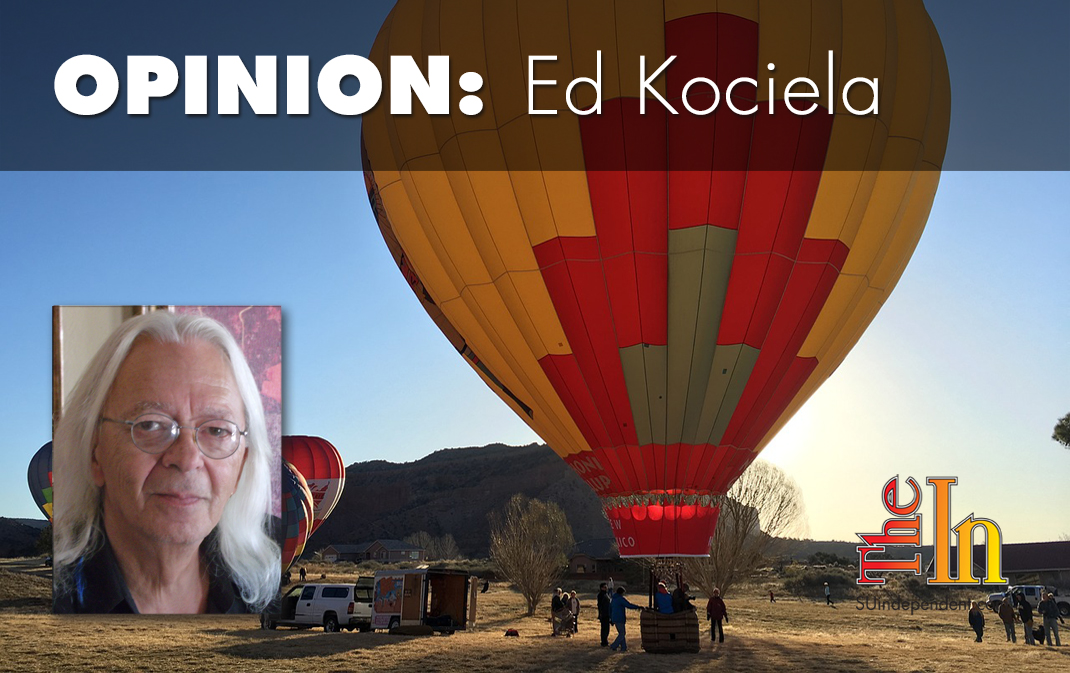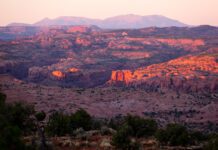
Frac sand mining would devastate southern Utah tourism
Kane County is one of those postcard communities where the vistas are stunning, where you can commune with Mother Nature in all her finest, where you can actually get away when you are looking to unplug your brain.
There are deserts, mountains, farmlands to take in. There is an abundance of wildlife. You can hike, fish, hunt, lose yourself in the beauty.
It provides easy access to national and state parks and national forests that make it a treasure for tourists whose idea of a good time is dodging the bright city lights in exchange for being swallowed up by skies so full of stars that you cannot possibly count them.
It is sinful that this gem is under siege.
But along with nature’s charms, there is a certain kind of sand in Kane County that is used in fracking — a method of extracting oil and gas from deep, underground pockets that are pounded with water and sand to release fossil fuels.
To get that sand, miners must first remove the topsoil. After stripping the topsoil, called the “overburden” in the industry, excavation begins on removing the sand, which involves heavy machinery and sometimes blasting, depending on how tightly the sands and silicates are packed.
The sand then goes through washing, drying, screening, and sorting cycles before being shipped off for use in fracking.
This process would change the vista in an area of natural beauty that brings in big tourism bucks and could upset the fragile ecological balance necessary for a sustainable agrarian economy.
Its impact can be as deleterious as fracking, which leaves an environmental scar that can range from desecration of the landscape to earthquakes as it shatters fissures in the underground rock formations to help the ooze of oil from the shale. It pollutes the waters, chases off wildlife, and makes the idyllic calm of nature clang with steely equipment and the noise created when fracking fluid is pumped into a well under dangerously high pressure, which can exceed 9,000 pounds per square inch to bust up the materials and extract the sand. The sand is a certain kind of silica sand found only in a few places in the United States.
Southern Red Sands, a company that mines frac sand, wants to operate a mine about 10 miles north of Kanab and sewed up a one-sided 20-year deal with the Kane County Water Conservancy District board to provide 600 acre-feet of water used in the process for a cost of $2 per 1,000 gallons of water used.
It’s a deal put together between former Utah legislator and executive director of the Kane County Water Conservancy District Mike Noel and Southern Red Sands operations manager and current Kane County Commissioner Andy Gant, who is one of Noel’s in-laws.
The issues here range, of course, from the possible conflict of interest as a result of the familial connection between Noel and Gant to the controversy over supplying water to southern Utah, particularly in the form of the Lake Powell Pipeline.
Politically, Kane County is not acclimated to progressive issues, especially when they relate to the environment.
It has not voted for a Democratic Party presidential candidate since Woodrow Wilson in 1916. It is the reddest county in one of the reddest states in the Union.
It’s where conservatives got their backs up when then-President Bill Clinton created the Grand Staircase-Escalante National Monument. Not only was Noel one of the strongest voices against the monument but he has also been a passionate opponent of the Southern Utah Wilderness Alliance and the Bureau of Land Management, who he claims want to “totally get rid of grazing” in areas of southern Utah. Of course, there could be another conflict of interest in that as well, because Noel owns a sprawling cattle ranch that covers more than several hundred acres.
It’s where environmental issues take a back seat to fattening wallets.
It’s where water, again, was an issue when planners for a nuclear reactor inked a deal for Kane County water, even as the pipeline discussions were heating up.
Surprisingly, a petition to put a stop to the sand mine was recently signed by 2,600 residents. Considering that Kane County had a population of 7,125 as of the 2010 United States Census, that’s a sizeable chunk of the population.
The impact of that petition remains to be seen, but I’m betting that it carries little weight with elected officials who, instead of tackling environmental issues, talk about the 40 jobs the frac sand mining operation might bring to the community. Plus, of course, the pockets that will be lined with water, land, and other side deals to put the mining operation into motion.
But the petition is a good start.
The tragedy in all of this is that fracking proponents toss out quotes and estimates of how the procedure will provide energy security, making the U.S. less dependent on foreign fossil fuels for years to come.
Despite the fact that there is ample evidence that fracking contaminates drinking water and the air we breathe and even causes earthquakes — most of them occurring near operations in Oklahoma and Ohio where the land has been pummeled — it is also evidence that public commitments to generating alternative energy sources that create cleaner sustainable power are smokescreens. They talk about the benefits of fracking far into the future while others, with an eye to sustaining the planet, talk about a conversion to sustainable fuels in the near future.
As is often the case in politics, the double-cross is also always in play as many of those who promise to pursue clean energy are being cascaded by powerful lobbyists who connect politicians with Big Oil to ensure the good health of Exxon-Mobil, Chevron, ConocoPhillips, and the others who plunder the Earth at the expense of humanity.
Still, if you want to bring dollars and cents into the equation, sand mining would prove to be an economic downer for southern Utah.
Frac sand mining, quite frankly, would have a devastating effect on southern Utah tourism. People come here for the beauty of the red rocks, the magnificent vistas, state and national parks. They don’t come here to see the land stripped of its natural splendor. They don’t come here to fall in line on the Interstate behind massive trucks hauling sand. They don’t come here to see nature exploited.
I remember southern Utah coming together to stop a couple of other potential environmental disasters. We stopped a coal plant that would have poisoned our air from coming to Mesquite, even though it had some heavy hitters behind it and was represented by Rudy Giuliani and his law firm.
We stopped the Department of Energy from resuming tests when it wanted to initiate the Divine Strake project at the Nevada Test Site, which would have kicked up God knows how many irradiated contaminants and tossed them into the air.
Let’s hope the grassroots effort behind the petition to stop this mine grows in numbers strong enough to prevent yet another bad idea.
Peace.
The viewpoints expressed above are those of the author and do not necessarily reflect those of The Independent.
How to submit an article, guest opinion piece, or letter to the editor to The Independent
Do you have something to say? Want your voice to be heard by thousands of readers? Send The Independent your letter to the editor or guest opinion piece. All submissions will be considered for publication by our editorial staff. If your letter or editorial is accepted, it will run on suindependent.com, and we’ll promote it through all of our social media channels. We may even decide to include it in our monthly print edition. Just follow our simple submission guidelines and make your voice heard:
—Submissions should be between 300 and 1,500 words.
—Submissions must be sent to editor@infowest.com as a .doc, .docx, .txt, or .rtf file.
—The subject line of the email containing your submission should read “Letter to the editor.”
—Attach your name to both the email and the document file (we don’t run anonymous letters).
—If you have a photo or image you’d like us to use and it’s in .jpg format, at least 1200 X 754 pixels large, and your intellectual property (you own the copyright), feel free to attach it as well, though we reserve the right to choose a different image.
—If you are on Twitter and would like a shout-out when your piece or letter is published, include that in your correspondence and we’ll give you a mention at the time of publication.




Good article, Ed! Fossil-fuel development is burgeoning but that doesn’t mean it or its associated activities such as this frac sand project have to wreak havoc everywhere, nor should they! The people of Kanab were able to stop Viresco’s coal gasification plant planned several years ago in Kane County. So perhaps they’ll be lucky enough to stop this. Readers can go to https://keepkanabunspoiled.org/ to see what they’re doing and how they can help. Let’s not ruin every jewel in Utah.